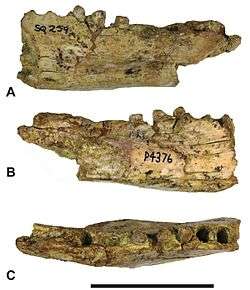Thylacinus megiriani
| Thylacinus megiriani Temporal range: Late Miocene | |
|---|---|
 | |
| Dentary | |
| Scientific classification | |
| Kingdom: | Animalia |
| Phylum: | Chordata |
| Class: | Mammalia |
| Infraclass: | Marsupialia |
| Order: | Dasyuromorphia |
| Family: | †Thylacinidae |
| Genus: | †Thylacinus |
| Species: | †T. megiriani |
| Binomial name | |
| Thylacinus megiriani | |
Thylacinus megiriani lived during the late Miocene. 8 million years ago the area T. megiriani inhabited was covered in forest with a permanent supply of water.
T. megiriani was a quadrupedal marsupial predator, that in appearance looked similar to a dog with a long snout. Its molar teeth were specialized for carnivory, the cups and crest were reduced or elongated to give the molars a cutting blade and in proportion with its body its teeth were exceptionally large, possibly adding to its body weight. Its estimated weight is over 57 kilograms.
It is thought that Thylacinus megiriani, along with crocodiles and giant monitor lizards were the only predators in Alcoota.
T. megiriani fossils along with T. potens have been discovered in Alcoota in the northern territory, although the remains of Thylacinus in Alcoota are very rare. Paleontologist have found specimens densely packed together that died within a matter of years of one another. It is theorized that drought and unpredictable weather were the cause.